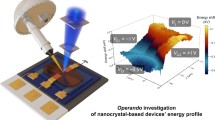Abstract
We study optical processes relevant to optical amplification and lasing in CdSe nanocrystal quantum dots (NQD). NQDs are freestanding nanoparticles prepared using solution-based organometallic reactions originally developed for the Cd chalcogenides, CdS, CdSe and CdTe [J. Am. Chem. Soc. 115, 8706 (1993)]. We investigate NQDs with diameters ranging from 2 to 8 nm. Due to strong quantum confinement, they exhibit size-dependent spectral tunability over an energy range as wide as several hundred meV. We observe a strong effect of the matrix/solvent on optical gain properties of CdSe NQDs. In most of the commonly used solvents (such as hexane and toluene), gain is suppressed due to strong photoinduced absorption associated with carriers trapped at solvent-related interface states. In contrast, matrix-free close packed NQD films (NQD solids) exhibit large optical gain with a magnitude that is sufficiently high for the optical gain to successfully compete with multiparticle Auger recombination [Science 287, 10117 (2000)]. These films exhibit narrowband stimulated emission at both cryogenic and room temperature, and the emission color is tunable with dot size [Science 290, 314 (2000)]. Moreover, the NQD films can be incorporated into microcavities of different geometries (micro-spheres, wires, tubes) that produce lasing in whispering gallery modes. The facile preparation, chemical flexibility and wide-range spectral tunability due to strong quantum confinement are the key advantages that should motivate research into NQD applications in optical amplifiers and lasers.
Similar content being viewed by others
References
M. Asada, Y. Miyamoto, and Y. Suematsu, IEEE J. Quantum Electron. QE-22, 1915 (1986).
N. N. Ledentsov, et al., Semiconductors 28, 832 (1994).
N. Kistaedter et al., Electron. Lett. 30, 1416 (1994).
M. Grundman, Physica E 5, 167 (2000).
C. B. Murray, D. J. Norris, and M. G. Bawendi, J. Am. Chem. Soc. 115, 8706 (1993).
V. Klimov and D. McBranch, Opt. Lett. 23, 277 (1998).
V. I. Klimov, Ch. J. Schwarz, D. W. McBranch, C. A. Leatherdale, and M. G. Bawendi, Phys. Rev. B 60, R2177 (1999).
V. I. Klimov, A. A. Mikhailovsky, Su Xu, A. Malko, J. A. Hollingsworth, C. A. Leatherdale, H.-J. Eisler, and M. G. Bawendi, Science 290, 314 (2000).
M. Nirmal et al., Phys. Rev. Lett. 75, 3728 (1995).
V. I. Klimov, A. A. Mikhailovsky, D. W. McBranch, C. A. Leatherdale, and M. G. Bawendi, Science 287, 10117 (2000).
D. Chepic, A. L. Efros, A. Ekimov, M. Ivanov, V. A. Kharchenko, and I. Kudriavtsev, J. Luminescence 47, 113 (1990).
In progress.
Author information
Authors and Affiliations
Rights and permissions
About this article
Cite this article
Hollingsworth, J.A., Mikhailovsky, A.A., Malko, A. et al. Nanocrystal Quantum Dots: Building Blocks for Tunable Optical Amplifiers and Lasers. MRS Online Proceedings Library 667, 61 (2000). https://doi.org/10.1557/PROC-667-G6.1
Published:
DOI: https://doi.org/10.1557/PROC-667-G6.1




